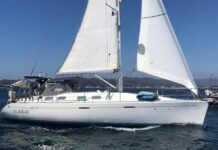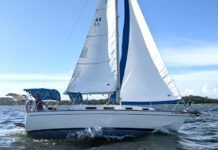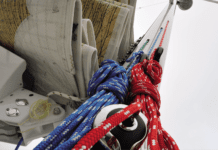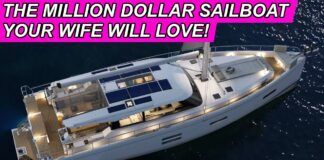As a follow up to Practical Sailors recent marine electronics report on mid-priced VHF radios, we evaluated three entry-level fixed-mount VHFs and three entry-level handheld VHFs priced at about $100. Marine radios in this price range lack some of the bells-and-whistles and safety features of higher-priced VHFs, but they will suit the needs of sailors on a budget or boaters looking for a backup VHF. The three fixed VHF radios tested were Cobra Marine F55, the Midland Regatta I and the Standard Horizon Eclipse GX1000S. Handheld radios tested were the Cobra MR HH325 VP, Midland Nautico NT3, and West Marine VHF55. Testers evaluated each radios transmitter, receiver, sound quality, display screen, and water resistance. Radio performance was also tested at extreme temperatures, and handheld models were dropped from 4 feet onto a concrete surface.
****
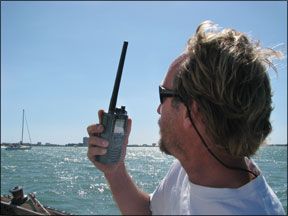
To follow up Practical Sailors recent report on mid-priced marine VHF radios (Practical Sailor, February 2009), we decided to take a look at some inexpensive offerings on the market. These entry-level electronics are well-suited for small-boaters and those on a budget-and lets face it, “budget boater” applies to most of us these days.
Testers found several handheld and fixed model VHFs that will get the job done for about $100. A fixed VHF is a better choice for boats that already have 12-volt systems in place. With a masthead antenna, they have better range than handhelds, and they arent hampered by the battery-life issues of portable electronics. But for those without 12-volt onboard power or those looking for an inexpensive backup to a fixed unit, handheld radios can fit the bill. Their strength is their portability. Being able to communicate via VHF from the dinghy, life raft, or ashore is always handy.
The VHFs in this price group don’t have many of the bells-and-whistles of their more costly brethren nor some of the advanced functions and safety features that full-time cruisers like. However, these basic marine radios do offer good transceiver performance wrapped in a weatherproof case and come with a three-year warranty, which is impressive for the price.
Practical Sailorlast looked at inexpensive fixed-mount VHFs in the July 15, 2005 issue and low-priced handhelds in the October 2006 issue.
What We Tested
Practical Sailor
testers evaluated three fixed-mount VHFs and three handhelds that fit the price point. Two of the fixed VHF makers, Cobra Marine and Midland Radio Corp., made a name for themselves in the citizens band (CB) radio market and in other electronics arenas. From Cobra, we tested the F55, and from Midland, the Regatta I. We rounded out the small field with the entry-level GX1000S from Standard Horizon, a well-known player in our tests and the marine electronics market.
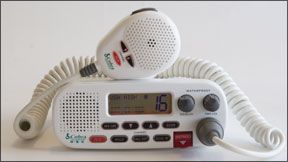
In the handheld VHF category, testers evaluated Cobras mid-sized MR HH325 VP, Midlands Nautico model NT3, and West Marines VHF55. Since this test began, Standard Horizon released a new handheld in this price range; look for a performance review of the new unit in an upcoming article.
Although all of the fixed models tested offer Digital Selective Calling (DSC), none of the tested handhelds have that feature. However, there are some more-expensive handhelds that offer DSC; look for a review of those in an upcoming issue.
All of the fixed-mount radios in this test are DSC class SC101, which means they have a single receiver listening for both voice communications and DSC digital data coming in over channel 70. DSC Class D radios have dual receivers-one to monitor voice channels and one to continuously monitor for digital data-but those radios are typically more expensive.
All of the fixed-mount VHFs we tested are submersible (rated for one meter for 30 minutes), but only two of the handhelds, the Cobra and the West Marine, can survive taking a dive. The Midland Nautico NT-3 handheld is only splash-resistant (JIS4), a significant limitation for a portable marine device.
All of the radios tested come with three-year warranties.
None of the inexpensive VHFs tested will float. We recommend attaching a buoyant lanyard or fob to any portable electronics, including these handhelds. Inexpensive does not mean disposable, and having a lanyard that can be snagged with a boathook will make the retrieval process easier.
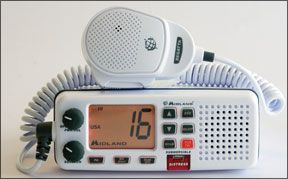
FIXED MOUNT
Cobra F55
Cobra Marines F55, a compact, entry-level VHF, provides for one-button operation of a number of key features, including making a DSC distress call, quick-selecting channel 16 or 9, initiating scans, setting channel group, and opening the menu page. Channel selection is made with up/down buttons on the radio or microphone, which also has a quick 16/9 button.
Menu-controlled functions include: display adjustment, weather alert, DSC calling, and DSC information entry. Small rotary knobs control power, volume, and squelch. Squelch did not function on weather channels.
The microphone connects to the radio with a metal, six-pin connector. Although the connector has a plastic cover, it is a possible point of corrosion in a saltwater environment.
The F55 will send and receive DSC distress, individual, and all ships calls, and will send and receive position data when its integrated with any NMEA 0183-capable GPS. Its directory can store up to 10 individual Maritime Mobile Service Identity (MMSI) numbers. The F55 also will display position data on screen when its hooked to any GPS with an NMEA 0183 output.
The F55 has two scan modes: all channels, which scans them in order, and dual-watch, which monitors channel 16 and the channel the radio was on when the scan was initiated.
The F55 transceiver was rated Excellent for frequency stability, but its transmitter output varied during testing and earned a Fair rating. At 86 decibels, audio output was average.
The F55 has a smallish screen, but testers found the large, block-style channel numbers easy to read. The screen also indicates the channel group selected, transmitter power setting, and when the radio is transmitting. Channel comments are not displayed, and the radio does not have a low-battery warning.
Bottom line: The Cobra exhibited average transceiver and audio performance, and it was the most expensive of the fixed models tested.
Midland Regatta I
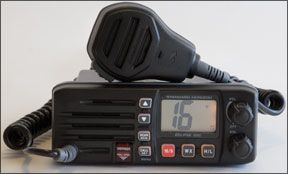
The Midland Regatta I is a mid-sized, no-frills VHF radio from Midland Radio Corp., a world-leader in two-way radio communications.
Operating the Regatta is super simple. There are no menus to dig through, and most functions-DSC distress call, quick-select channel 16/9, scanning modes, and turning public address (PA) mode on or off-are operated with a single button push. The only operation that has any semblance of a menu is the DSC function.
The Regatta has very limited DSC capability. It will send and receive DSC distress, individual, and all ships calls, but it does not have a call directory. Having to manually enter the nine-digit MMSI number each time an individual DSC call is made (and keep those numbers stored elsewhere) is a drawback, but it will be of little importance to those who don’t make frequent DSC calls.
The Regatta, like the Cobra, is compatible with all GPS units that have NMEA 0183 outputs, but-unlike the other fixed models-the Midland does not display position information or transmit it on DSC.
The Regatta has two scan modes, tri-watch and all channels. Tri-watch monitors channels 16 and 9 and whatever channel the radio was on when tri-watch was selected. The radio also has a basic hailer function that provides voice over a public address horn by simply pressing the “PA” button. Small rotary knobs control power, volume, and squelch, and channel selection is made with up/down buttons.
This radio performed well in our testing, earning an Excellent for transmitter power stability and a Good for transmitter frequency stability. With a measured audio output of 91 dBA, it bested all radios in its price range.

The Midland Regatta earned a Good for its large display with very large block-style channel numbers. On-screen icons appear for transmitter power, channel group, transmitting, scan, and tri-watch. Channel comments are not displayed, and the radio lacks a low-battery warning.
Bottom line: The Midland Regatta I bested the competition in overall performance and user-friendliness. Its a great buy for the sailor who likes the hailer function and doesn’t plan to integrate navigation and communications systems, and so it gets our recommendation.
Standard Horizon Eclipse
The Standard Horizon Eclipse GX1000S is a compact, easy-to-operate, entry-level marine VHF.
Rotary knobs control power, volume, and squelch. Channel selection is made with up/down arrow keys. Dedicated buttons can toggle between the last selected channel and 16/9, between voice and weather channels, change transmitter power, and operate scanning functions. Some scanning options, backlight adjustment, weather alert on/off, and setting time/location and offset are handled via menu.
The Eclipse will send and receive DSC distress, individual, and all ships calls, and send and receive position data when connected to a GPS (any with an NMEA 0183 output). It will store up to 15 boat names and MMSI numbers for DSC.
This radios scan modes differ from the other fixed models. The Eclipse offers memory and priority scanning, once the desired channels are entered into the radios memory. Memory scan looks at all channels in memory in numerical order. Priority scan inserts a stop at channel 16 between each memory channel.
We found transmitter power output and frequency accuracy to be stable throughout our tests. At 70 decibels, receiver selectivity is very good. However, audio output was a bit weak, measuring only 84 dBA in our testing. This radio has a low-battery indicator that signals when power drops low enough to affect transmission capabilities at high power. In our tests, increasing the voltage above 12.4 turned the warning off.
The Eclipse display shows large block channel numbers with alpha indicated for the appropriate channels. It was the only fixed VHF tested that displayed channel comments; they scroll across a five-character line at the bottom of the screen. When the radio is connected to a GPS, time and position can be displayed on the comment line.
Frequency group, transmitter power, and transmit/receive icons are also shown on screen. We rated the display Good.
Bottom line: The Standard Horizon Eclipse has a small footprint, good features, and good transceiver performance, and it was the cheapest in its category. Its audio system is a bit weaker than the others in this test, but it earns our overall pick for Best Choice among inexpensive, fixed VHFs.

VHF HANDHELDs
Cobra HH325 VP
The Cobra MR HH325 VP is solidly constructed on a die-cast aluminum frame. At 15.5 ounces-about twice as heavy as the other handhelds tested-it certainly is no lightweight.
The HH325s supplied AC charger requires 14 hours to fully charge the units 1500 mAH nickel metal-hydride battery. A DC charger cord, belt clip, and wrist strap are also included, but the AA battery case is optional.
One unique feature of the HH325 is its battery saver mode. If no transmission is made after 10 seconds, the unit switches to this mode to conserve battery power. Volume and squelch knobs are mounted on top of the radios casing, next to a jack for an external speaker or microphone. The push-to-talk switch and lock buttons are side-mounted.
Remaining functions are controlled using eight pushbuttons. One-button control is available for such functions as selecting transmitter power, channels, weather channels, quick channel 16/9, and some scanning options. Transmitter power can be set to 5, 3, or 1 watt(s).
Three scan modes are offered: numerical, memory, and tri-watch. In the tri-watch mode, channel 16 will always be one of the scanned channels; the other two are user-programmable. The HH325 is capable of sending a call tone to other VHF radios able to receive it. When it receives a call tone, it will respond with a vibration or tone alarm, as set by the user. The HH325 can use all Canadian, international, and U.S. channels and all 10 NOAA weather alert channels. In the event of threatening weather, the HH325 sounds an audible warning and displays a visual alarm, an impressive bonus feature.
The HH325 screen is big and displays much information. Large block-style numbers show the selected channel while a single, smaller letter tells which channel group is selected. A screen icon continuously gives the status of the battery, and illuminated function keys make night-time operations easier.
One notable feature on this radio is its signal-strength meter, which displays the power of the transmitted or received signal.
The HH325 transceiver performed about average. It earned Good ratings for transmitter power stability and receiver sensitivity, but only a Fair for transmitter frequency stability. Audio performance was Good, as it managed a healthy 93 dBA reading during our output test.
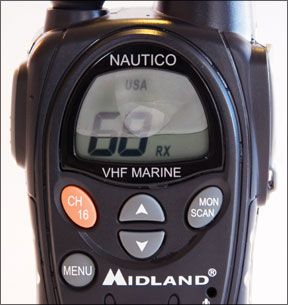
This radio ran for 11 hours solid, then refused to transmit due to a weak battery. It passed both the drop and submersion tests with no glitches.
Bottom line: The Cobra HH325 offers decent performance, solid construction, and adequate features for the money. Its thePractical Sailor Best Choice for inexpensive VHF handhelds.
Midland Nautico NT3
Midland Radio is well-known for its CB radios and a variety of other radio and telemetry gear.
We tested its Nautico NT3 handheld. Before testing, we charged the Nauticos Ni-Cad battery for 24 hours with the supplied AC charger. (According to the manual, subsequent charges should take only about eight to 12 hours.) The radio can also operate on four AA batteries, but alkalines typically have a shorter life than Ni-Cad. It also comes with a holder, mounting hardware, a DC charger, and a mic headset.
The Nautico has a top-mounted knob for volume and power control. Both the push-to-talk button and jack (microphone/speaker jack/ battery charger) are under plastic covers. Five pushbuttons control the radios limited functions, but they are not backlit, which makes operating the unit in the dark more of a challenge.
Squelch is not adjustable on this radio; it is controlled automatically for a “whisper quiet” radio, according to Midland. The Nautico can use all U.S., Canadian, and international channels, and all 10 NOAA hazards alert channels. The Nautico has only one scan option: all channels, in order.
Testers found the Nautico tedious to operate. Users must move from channel 16 and press “MENU” before the arrow keys can be used to select a channel. They also must move from channel 16 in order for the “MENU” key to function on anything other than transmitter power.
The Nautico display screen is fairly small, but was rated Good for its readable block letters. No channel comments are displayed, but channel group and alpha channels are shown when selected. An on-screen icon indicates battery life.
The Nautico had average performance in our transceiver tests, but audio output was a rather anemic 86 dBA. The radio passed the drop test but stopped transmitting at Hour 9 of the battery life test. Even though its advertised as “waterproof,” the Nautico flooded during our immersion test and became inoperable. Its not rated for submersion, a major drawback in our eyes.
Bottom line: The Midland Nautico NT3 was difficult to operate and lacked adequate waterproofing for the marine environment.
West Marine VHF 55

New Jersey-based BG Tech (http://www.bgtechamerica.com/) manufactures the VHF55 for West Marine. At just under 9 ounces, the West Marine VHF55 is compact and lightweight. Not much larger than a cell-phone, it fits in the hand nicely.
The included AC charger will fully charge the VHF55s Lithium Ion battery in about 12 hours. (An alkaline battery pack is not available for this radio.)
This entry-level radio has only basic functions, and all are controlled by eight backlit pushbuttons. We like rotary knobs for volume and squelch control, but West Marines “knobless” design allows the VHF to fit easily into a pocket or cell-phone belt clip, according to the retailer, and should protect the radio from water intrusion.
“The O-rings on knobs and the rubber plugs on sockets are typically the weakest links in a waterproof system on the handheld product,” explained West Marine Category Manager Gary Williamson.
The VHF55 offers dual-watch and memory scan modes, and quick select channel 16/ 9. This radio operates on all Canadian, international, and U.S. channels.
The display-rated Excellent-uses large channel numbers and letters, and also offers battery level and volume meters, and a high/low transmitter icon.
Overall performance of the VHF55 was above average. Highlights included top ratings for transceiver performance and best-in-class results in our battery life test. It was still going strong at 15 hours. The audio system performed well too, hitting 94 dBA in our output test.
Some negatives testers noted were the VHF55s lack of weather alerts and lack of a provision for an external microphone or speaker. We also were unable to find a replacement battery for the VHF55. At presstime, West Marine was out of stock but reported that units had been ordered.
Bottom line: The West Marine VHF55 is small, offers a long battery life, excellent display, and good performance. Its lack of a 12-volt charger and the battery replacement (for the moment) hold it back.
Conclusion
In this price range, you wont find THE perfect radio, but you can find one thats a good value. Small-boaters and weekend cruisers on a budget will get their moneys worth with the Standard Horizon Eclipse fixed radio, an above-average performer with a low price, full DSC function, and the ability to link to the ships GPS. A top performer with hailer capability but limited DSC, the Midland Regatta is recommended, but we continue to prefer the safety advantages of GPS-compatible DSC function.
Cobras average performance and higher price kept it out of the winners circle in the fixed category, but the companys HH325 led the pack among inexpensive handhelds. Its solid construction, large easy-to-read display, decent performance, and unique features earned it thePractical Sailor Best Choice title for portable radios.



